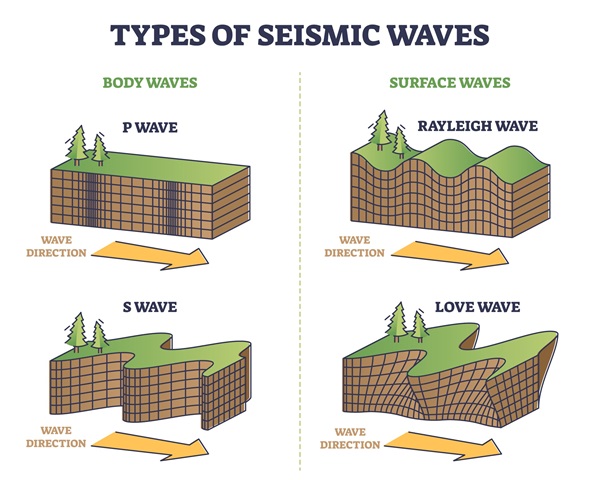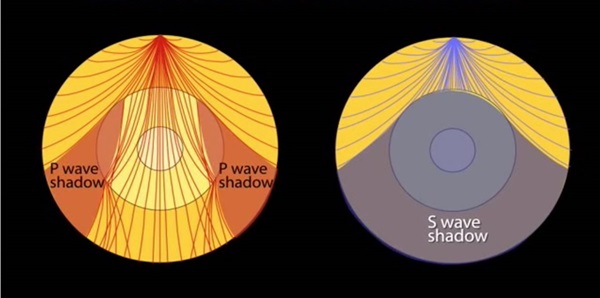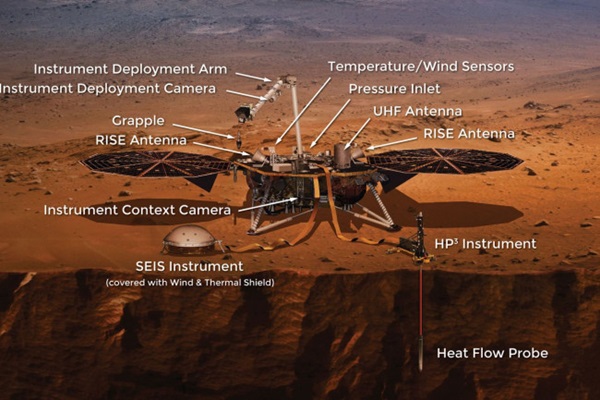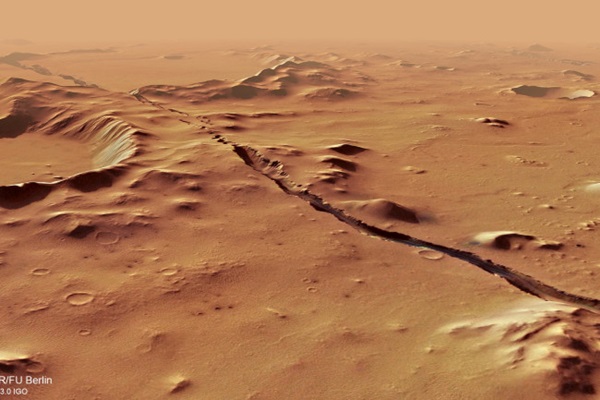Key Takeaways:
Understanding what’s inside of a planet is like trying to figure out what’s inside of a gift without unwrapping it. But because we can’t simply tear open a planet, instead, we must rely on secondary evidence, like the waves generated by geologic events.
Seismology — the study of quakes and seismic waves — lets us take “images” of the interiors of planets. NASA’s Viking landers brought the first seismometers to Mars in 1976, but they were plagued by noise, which rendered them largely ineffective. It took more than 40 years until Mars hosted another mission equipped with a quake-measuring instrument: NASA’s InSight lander.
And although InSight is expected to retire later this year, ever since the lander touched down in 2018, this stationary surveyor has been studying marsquakes, slowly unveiling the interior of the Red Planet.
What’s shaking?
Seismic waves are the by-products of geologic events. They are the result of energy being released when a planet experiences the movement of faults, rising magma flows, impacts from space, massive landslides, and more. Much of that energy is spent grinding, melting, and/or moving rocks, but a fraction of it is converted into waves that travel away from the epicenter of the event.
Scientists use seismometers to measure exactly how the ground moves in response to these passing seismic waves, monitoring any movement in up to three primary directions. On Earth, seismometers are most useful for determining the location, magnitude, and depth of an earthquake. On Mars, however, the main goal of these devices is to provide a window into the inner structure of the planet itself.
Seismic waves, however, are not all the same. During an earthquake (or marsquake), four main types of waves are generated: p-waves, s-waves, Love waves, and Rayleigh waves.
P-waves and s-waves make up a group called body waves, which travel through rock. The fastest are p-waves (primary, or compression waves), which squeeze rocks as they race through them. The movement of these waves is akin to someone in the back of a line shoving the person in front of them. As p-waves pass through different materials, they speed up and slow down, and that changes their path. So, by mapping how these p-waves change direction, scientists can attempt to piece together a planet’s internal layering and composition.
The other type of body wave is called an s-wave (secondary, or shear wave), and these are the second fastest type of seismic wave. S-waves move rock perpendicular to the direction the wave is moving, like shaking a beach towel to fling off sand. In order to propagate, S-waves require material that has some internal strength and rigidity. This means that s-waves can’t pass through liquids, including our planet’s liquid metallic outer core.
The last two seismic waves make up a group called surface waves. On Earth, these are the waves that cause the most devastation. The first type, Love waves, oscillate the surface from side to side (horizontally). Meanwhile, the other type, Rayleigh waves, move through the surface like an ocean wave (vertically). When we feel the ground shaking during an earthquake, Love waves and Rayleigh waves are usually what we’re feeling.
Inside looking out
Inside Earth, p- and s-waves speed up as you get deeper into the planet’s crust and mantle. There are some variations as the waves transition from the brittle crust to the malleable mantle to the dense core, but in general, they travel faster at greater depth. This is due to the changing pressure (and thus density) of Earth’s interior, as well as changes in the minerals that make up the mantle.
When the seismic waves hit Earth’s mantle-core boundary, big things happen. First, the s-waves disappear because the outer core of Earth is liquid. Remember, s-waves shear rocks, and with nothing to shear, they vanish. However, the s-waves return in the planet’s solid inner core. That’s because s-waves, or secondary waves, are mostly a byproduct of the movement of p-waves, or primary waves.
Meanwhile, p-wave velocities drop dramatically at the mantle-core boundary. That’s because they are going from silica-rich rocks to an iron-nickel core. In fact, inside Earth, p-waves drop in velocity by almost 50 percent. However, p-waves again speed up as they travel deeper into Earth’s outer and inner core.
After both s- and p-waves make their way through Earth’s core, their speeds change again — but this time in reverse, as they are now venturing from core out to crust.
In the shadows
Planets and moons are spheres. So, whether an earthquake, marsquake, or moonquake, a quake will send seismic waves that move in an arc-like shape through the world’s interior (see the image below). When these waves hit different materials, they increase or decrease in speed, causing their paths to bend. This phenomenon is known as refraction, and it’s the same thing that happens when light (which can be a wave) passes through a lens.
A seismometer positioned on a planet that experiences a quake will detect the arrival of p- and s-waves, allowing scientists to calculate the waves’ average velocities. And if there are multiple seismometers scattered around the world, the waves will arrive at some stations but not others, depending on how much the seismic waves were refracted along the way. This can lead to what are called “shadow zones.”
To understand how various waves travel through a world, planetary geologists input the arrival times (wave velocities), as well as the location and size of the shadow zones (wave phases), into models. Based on deviations between what the model predicts and what was observed, scientists then further tweak and refine their model to determine the best set of parameters that replicates the seismic data.
In other words, by unravelling the multitude of seismic waves produced during a quake, scientists can estimate the compositions and dimensions of a world’s various layers.
InSight’s insights into Mars
Over the past several years, the seismic data collected by NASA’s InSight lander has revealed that Mars is still a geologically active world. However, both the rate and intensity of geological activity on Mars pales in comparison to what we experience on Earth. So far, in about four years, InSight has detected only one magnitude-5 marsquake. For comparison, our planet experiences hundreds of magnitude-5 earthquakes every month.
Despite a lack of many powerful marsquakes, InSight has detected hundreds of smaller quakes, which are still valuable for refining models of Mars’ interior. So far, we know the martian crust is thin, going down to a depth of only some 12 to 23 miles (20 to 37 kilometers). Mars’ mantle then stretches down another roughly 970 miles (1,560 km). And the martian core appears to be fully liquid, rather than the dichotomous liquid-solid core that Earth has.
The InSight mission has helped scientists peel back the layers of Mars’ interior, providing planetary scientists with years of data that could answer questions about Mars’ lack of both plate tectonics and a strong magnetic field. And that’s just the start. Future missions capable of collecting seismic data may soon venture to other planets and moons beyond Mars, allowing scientists to peer into the hearts of some of the solar system’s most intriguing objects.














